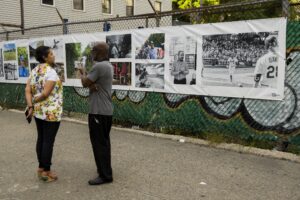Latin American Foto Festival features works in outdoor locations, from many countries.
Images of Dominican baseball players, El Salvadoran traditionalists, and Chilean expats in Brazil are visible on the streets of Melrose.
Those are the signs that the Bronx Documentary Center’s “Latino American Foto Festival” is back for its fifth consecutive run through the end of July, with large-scale outdoor and indoor photo projects by emerging artists and award-winning photographers.
The Dominican Republic has produced a disproportionately high number of Major League baseball stars over the years, and photographer Sofia Torres Prida, a native of the island, documents them “viewed from unconventional perspectives” in “Dreams and Glory.” That exhibit hangs next to the Documentary Center’s building at 614 Courtlandt Avenue, and marks Torres Prida’s debut in the city. The local reaction surprised her.
Justo Rafael Novas, 60, a native of the Dominican Republic who lives near the Center was in a hurry on July 24, opening day for the festival, but he stopped when he recognized famous players among Torres Prida’s profiles.
He excitedly paced along the sidewalk, video chatting on his cellphone, pointing it at the photos and emphatically telling someone on the other line, “Look! Who is that?” while moving between each photo. He pointed the phone over toward the photographer, and enthusiastically pronounced “that’s the artists over there.”
The passerby’s reaction was typical of the kind of excited responses Torres Prida’s photos elicited.
“These are the type of people that I want to see happy and get excited about the work,” she said, adding, “these are not only baseball players, they are Dominicans. And we as Dominicans are extremely proud of them.”
Cynthia Rivera, the festival’s curator and the Doc Center’s exhibition coordinator, said the works are tailor-made for the neighborhood they are being shown in.
“The outdoor exhibitions are a great opportunity to bring the community in,” said Rivera, a native of Melrose. “This is predominantly an immigrant neighborhood.”
Through the works on display, Melrose residents get a chance to see reflections of the places they are from, such as in the joint works of Yael Martinez and Sergio Ortiz Borbadilla. Their “Looking for Hope at the End of the Road” documents the journey of refugees coming north from Central and South America, many of whom are unable to complete the journey due to the dangers they encounter en route.

Other projects touch on ancestry, roots, and culture, such as “Isolated Soul” by Chilean photographer Tamara Merino, from Brazil. Her photos are meant to evoke “a deep emotional state of nostalgia and profound melancholy, or ‘saudade,” a term widely used in Brazil to depict nostalgia—-with a tinge of sadness.
In all, this year’s festival profiles 10 photographers and collectives, depicting scenes from more than 11 Latin American countries, with traditional photo prints, as well as interactive projects.
Some projects are highly personal, and took a decade to develop, like the one by Jose Cabezas, a photojournalist for Reuters who documents breaking news, business, and daily life in El Salvador. He made “Danzantes de la Historia ” or Dancers of History, during one of the most violent periods in that nation’s history. The photos spotlight a fading 300-year-old tradition that “survives in the cracks of society,” with dance rituals that depict Crusades-era allegories adopted by the indigenous people as a way to criticize colonialism and keep their own traditions alive, to “worship their own deities.”
Cabezas became emotional when speaking of his subject.
“I want to tell a different story of El Salvador” instead of the media depictions of a country torn by endless gang violence, he said. It was also an opportunity for him to capture images of people he encountered in small towns, in a way they may want to be remembered.
“I made the commitment to go back and bring back the images with me to give it to them,” he said. “Maybe it was the only picture they had dressed with dignity.”
In some instances, the photos he took were the ones used at the funerals of the townspeople, when they were among the scores killed in the country’s infamous violence.
The artists included in the exhibit are José Cabezas, Héctor Guerrero, Yael Martínez and Sergio Ortiz Borbolla, Tamara Merino, the Nuevayorkinos project, Alejandro Olivares, Paola Paredes, Sofía Torres Prida, Annie Y. Saldaña, and a collective project directed by Jorge Panchoaga.
Rivera, who curated the festival along with the Bronx Documentary Center’s founder and executive director Michael Kamber, said that by hanging the photos all over Melrose, she hopes residents “can see themselves within certain stories.”
More information about the festival can be found here: Latin American Foto Festival: Indoor + Outdoor Exhibition

